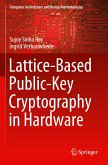Systems for public key cryptography are intensively applied in digital processes in order to sign or encrypt data and assure data integrity, confidentiality, and authentication and non-repudiation for a data signer. The complexity of computations has impact on performance of the systems, especially in case of high key lengths. In the book we analyse and implement two underlying building blocks for public-key cryptography systems: modular multiplier and random number generator. Choosing FPGA circuits as a target platform for the analysed elements allows reducing the development time and brings advantages in area of security. We show what impact on the system performance have the parameters of the processing blocks and algorithm improvements. The key generating element a Random Number Generator (RNG) is analysed under several aspects and we provide results in the form of a stochastic model of the RNG and propose testing methods suitable for this type of RNGs.








